Trademark Registration and Brand Building: A Case Study Report
VerifiedAdded on 2020/02/24
|11
|2317
|119
Report
AI Summary
This report presents a case study on the significance of trademark registration for a start-up irrigation enterprise. It explores the importance of trademarks in distinguishing products and building brand goodwill, emphasizing the broader concept of Intellectual Property, including patents and copyrights, within the Australian legal framework. The report analyzes a hypothetical start-up, "FLNN- Solution to Irrigation," and its approach to trademarking a unique design for products aimed at the mining sector. It details the trademark registration process in Australia, governed by IP Australia, and discusses various trademark types, such as certification marks, highlighting the importance of innovation, uniqueness, and purpose in trademark design. The report concludes by underscoring the critical role of trademarks in establishing and protecting a business's identity and legal rights.

Running head: INTELLECTUAL PROPERTY
Intellectual Property
Name of the student:
Name of the University:
Author Note
Intellectual Property
Name of the student:
Name of the University:
Author Note
Paraphrase This Document
Need a fresh take? Get an instant paraphrase of this document with our AI Paraphraser

1INTELLECTUAL PROPERTY
Executive Summary
The main aim of this report is to show why trademark and its registration are necessary. This
report is based upon a case study which speaks about how Intellectual Property can be
applied while building up a brand image for a start up irrigation enterprise. This report also
shows how trademark is not only important to distinguish a product but also how it helps in
building goodwill in the market.
Executive Summary
The main aim of this report is to show why trademark and its registration are necessary. This
report is based upon a case study which speaks about how Intellectual Property can be
applied while building up a brand image for a start up irrigation enterprise. This report also
shows how trademark is not only important to distinguish a product but also how it helps in
building goodwill in the market.

2INTELLECTUAL PROPERTY
Table of Contents
Introduction................................................................................................................................3
Discussion..................................................................................................................................4
Conclusion..................................................................................................................................8
Reference List:...........................................................................................................................9
Table of Contents
Introduction................................................................................................................................3
Discussion..................................................................................................................................4
Conclusion..................................................................................................................................8
Reference List:...........................................................................................................................9
⊘ This is a preview!⊘
Do you want full access?
Subscribe today to unlock all pages.

Trusted by 1+ million students worldwide
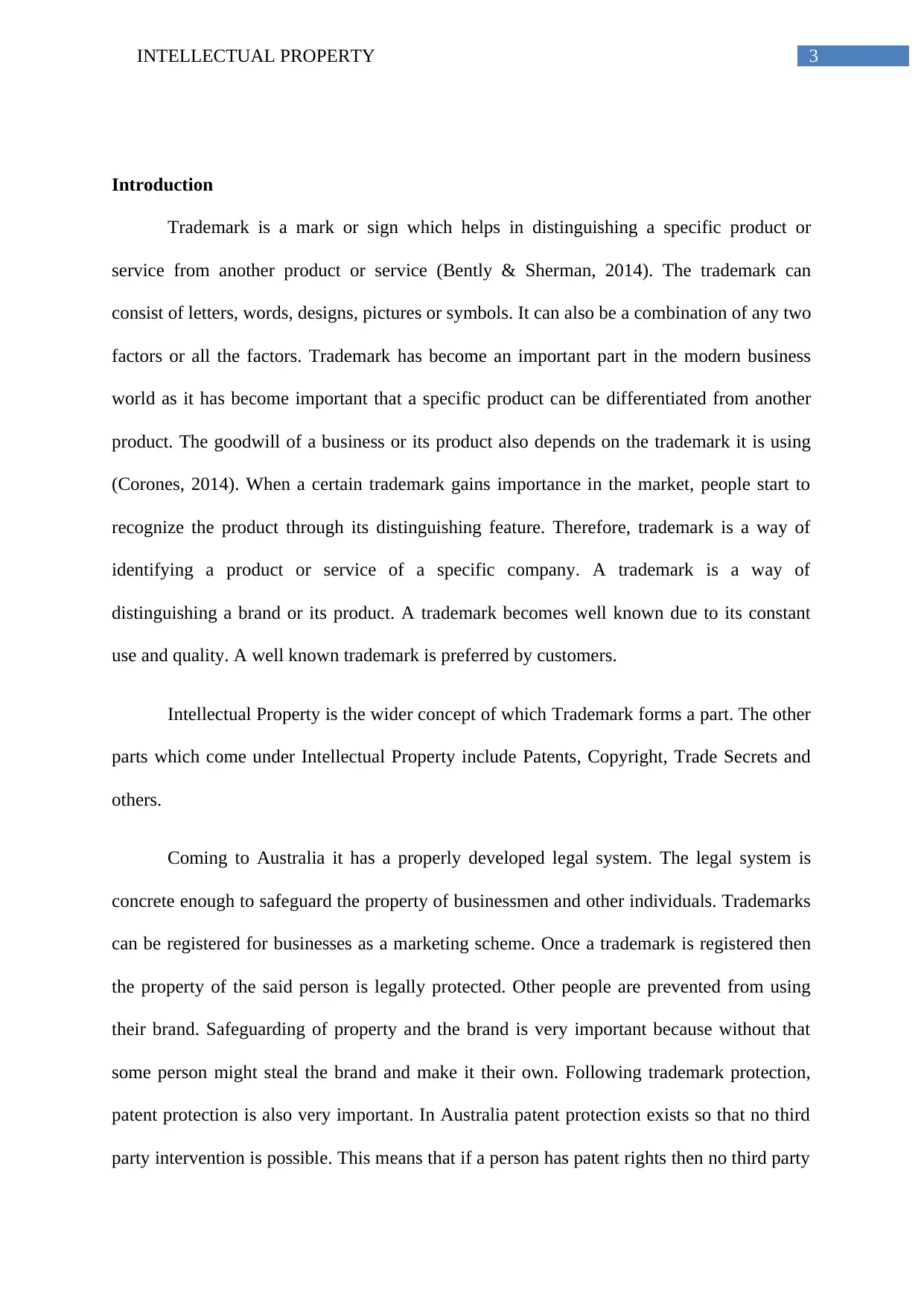
3INTELLECTUAL PROPERTY
Introduction
Trademark is a mark or sign which helps in distinguishing a specific product or
service from another product or service (Bently & Sherman, 2014). The trademark can
consist of letters, words, designs, pictures or symbols. It can also be a combination of any two
factors or all the factors. Trademark has become an important part in the modern business
world as it has become important that a specific product can be differentiated from another
product. The goodwill of a business or its product also depends on the trademark it is using
(Corones, 2014). When a certain trademark gains importance in the market, people start to
recognize the product through its distinguishing feature. Therefore, trademark is a way of
identifying a product or service of a specific company. A trademark is a way of
distinguishing a brand or its product. A trademark becomes well known due to its constant
use and quality. A well known trademark is preferred by customers.
Intellectual Property is the wider concept of which Trademark forms a part. The other
parts which come under Intellectual Property include Patents, Copyright, Trade Secrets and
others.
Coming to Australia it has a properly developed legal system. The legal system is
concrete enough to safeguard the property of businessmen and other individuals. Trademarks
can be registered for businesses as a marketing scheme. Once a trademark is registered then
the property of the said person is legally protected. Other people are prevented from using
their brand. Safeguarding of property and the brand is very important because without that
some person might steal the brand and make it their own. Following trademark protection,
patent protection is also very important. In Australia patent protection exists so that no third
party intervention is possible. This means that if a person has patent rights then no third party
Introduction
Trademark is a mark or sign which helps in distinguishing a specific product or
service from another product or service (Bently & Sherman, 2014). The trademark can
consist of letters, words, designs, pictures or symbols. It can also be a combination of any two
factors or all the factors. Trademark has become an important part in the modern business
world as it has become important that a specific product can be differentiated from another
product. The goodwill of a business or its product also depends on the trademark it is using
(Corones, 2014). When a certain trademark gains importance in the market, people start to
recognize the product through its distinguishing feature. Therefore, trademark is a way of
identifying a product or service of a specific company. A trademark is a way of
distinguishing a brand or its product. A trademark becomes well known due to its constant
use and quality. A well known trademark is preferred by customers.
Intellectual Property is the wider concept of which Trademark forms a part. The other
parts which come under Intellectual Property include Patents, Copyright, Trade Secrets and
others.
Coming to Australia it has a properly developed legal system. The legal system is
concrete enough to safeguard the property of businessmen and other individuals. Trademarks
can be registered for businesses as a marketing scheme. Once a trademark is registered then
the property of the said person is legally protected. Other people are prevented from using
their brand. Safeguarding of property and the brand is very important because without that
some person might steal the brand and make it their own. Following trademark protection,
patent protection is also very important. In Australia patent protection exists so that no third
party intervention is possible. This means that if a person has patent rights then no third party
Paraphrase This Document
Need a fresh take? Get an instant paraphrase of this document with our AI Paraphraser
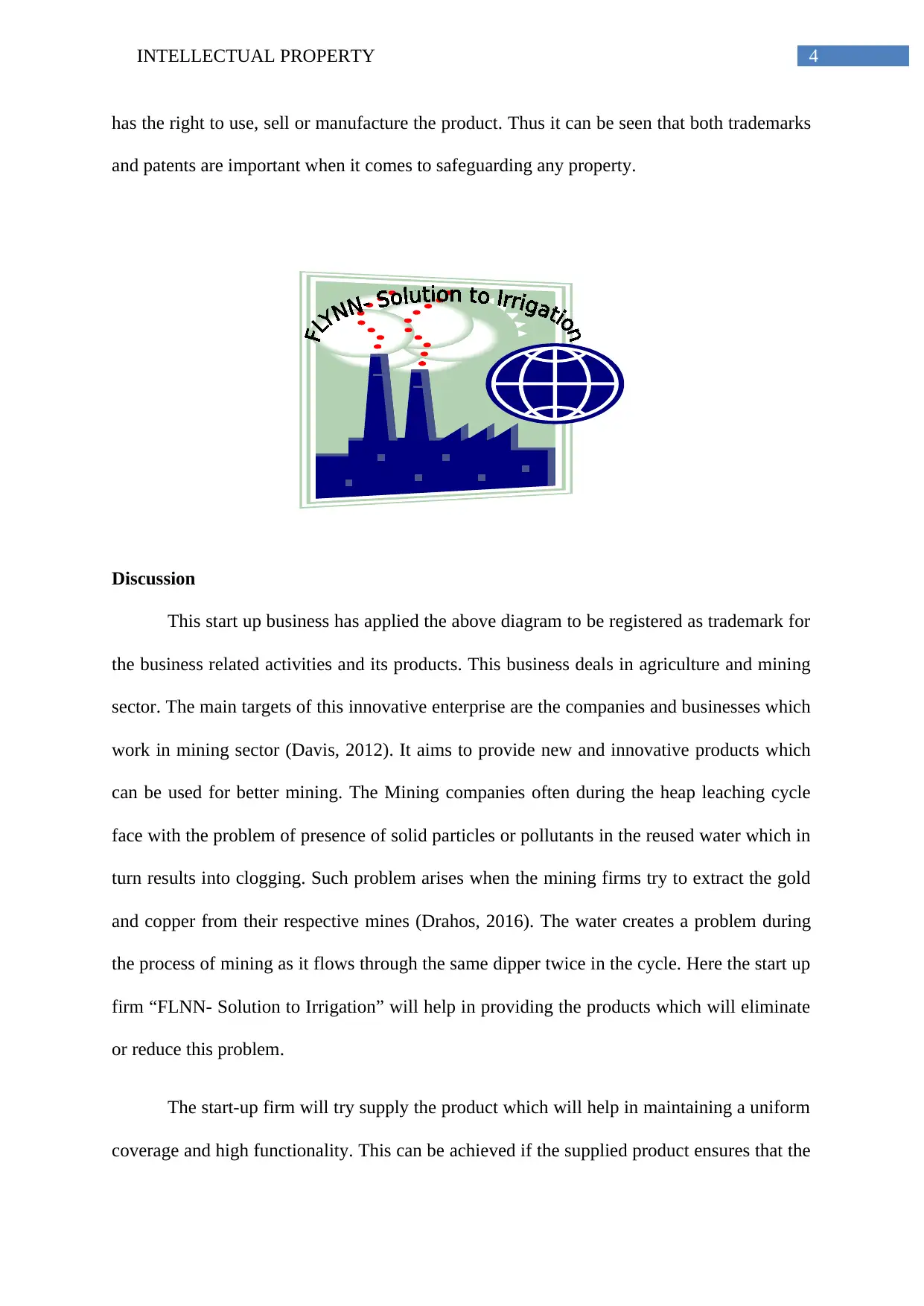
4INTELLECTUAL PROPERTY
has the right to use, sell or manufacture the product. Thus it can be seen that both trademarks
and patents are important when it comes to safeguarding any property.
Discussion
This start up business has applied the above diagram to be registered as trademark for
the business related activities and its products. This business deals in agriculture and mining
sector. The main targets of this innovative enterprise are the companies and businesses which
work in mining sector (Davis, 2012). It aims to provide new and innovative products which
can be used for better mining. The Mining companies often during the heap leaching cycle
face with the problem of presence of solid particles or pollutants in the reused water which in
turn results into clogging. Such problem arises when the mining firms try to extract the gold
and copper from their respective mines (Drahos, 2016). The water creates a problem during
the process of mining as it flows through the same dipper twice in the cycle. Here the start up
firm “FLNN- Solution to Irrigation” will help in providing the products which will eliminate
or reduce this problem.
The start-up firm will try supply the product which will help in maintaining a uniform
coverage and high functionality. This can be achieved if the supplied product ensures that the
has the right to use, sell or manufacture the product. Thus it can be seen that both trademarks
and patents are important when it comes to safeguarding any property.
Discussion
This start up business has applied the above diagram to be registered as trademark for
the business related activities and its products. This business deals in agriculture and mining
sector. The main targets of this innovative enterprise are the companies and businesses which
work in mining sector (Davis, 2012). It aims to provide new and innovative products which
can be used for better mining. The Mining companies often during the heap leaching cycle
face with the problem of presence of solid particles or pollutants in the reused water which in
turn results into clogging. Such problem arises when the mining firms try to extract the gold
and copper from their respective mines (Drahos, 2016). The water creates a problem during
the process of mining as it flows through the same dipper twice in the cycle. Here the start up
firm “FLNN- Solution to Irrigation” will help in providing the products which will eliminate
or reduce this problem.
The start-up firm will try supply the product which will help in maintaining a uniform
coverage and high functionality. This can be achieved if the supplied product ensures that the
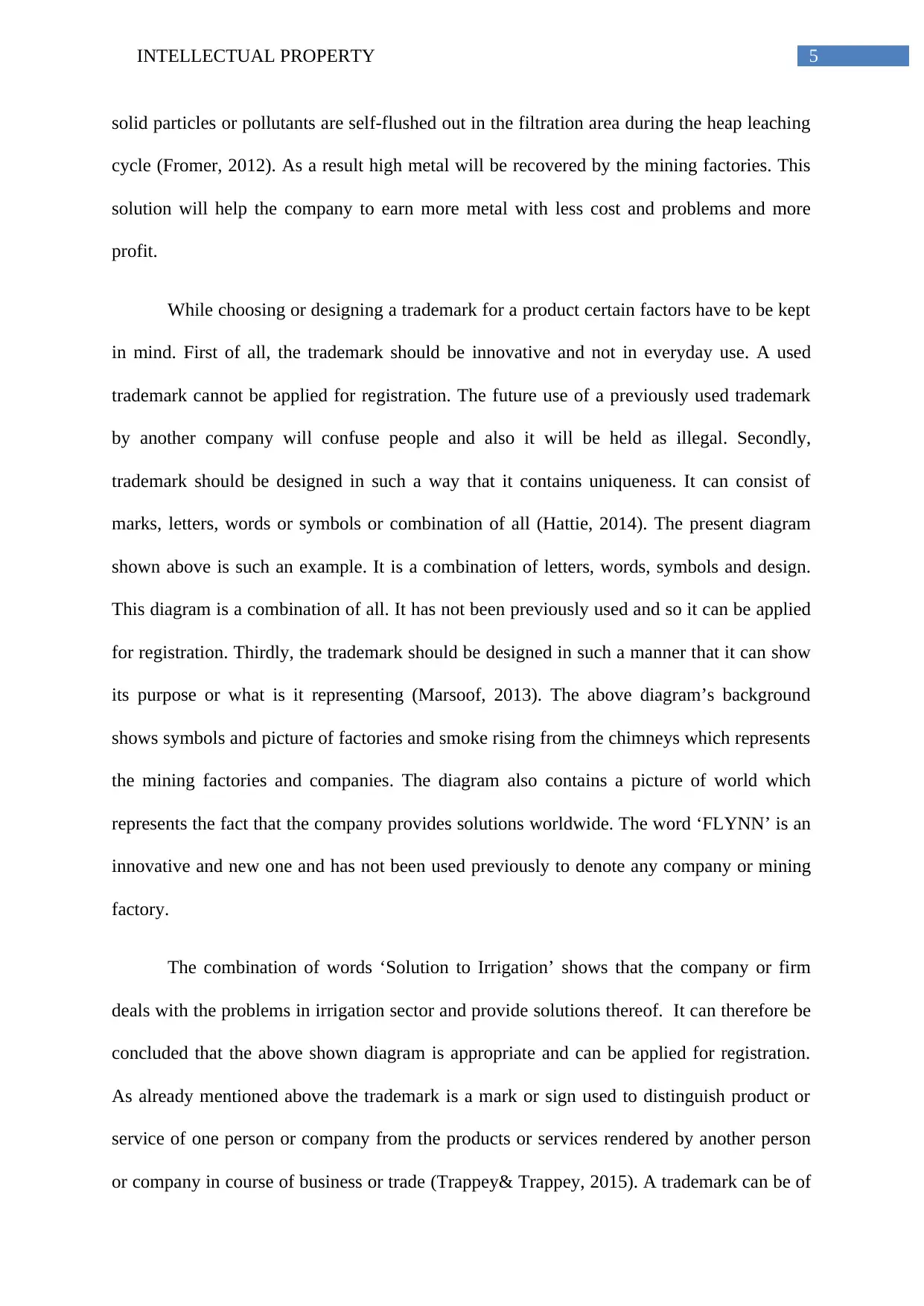
5INTELLECTUAL PROPERTY
solid particles or pollutants are self-flushed out in the filtration area during the heap leaching
cycle (Fromer, 2012). As a result high metal will be recovered by the mining factories. This
solution will help the company to earn more metal with less cost and problems and more
profit.
While choosing or designing a trademark for a product certain factors have to be kept
in mind. First of all, the trademark should be innovative and not in everyday use. A used
trademark cannot be applied for registration. The future use of a previously used trademark
by another company will confuse people and also it will be held as illegal. Secondly,
trademark should be designed in such a way that it contains uniqueness. It can consist of
marks, letters, words or symbols or combination of all (Hattie, 2014). The present diagram
shown above is such an example. It is a combination of letters, words, symbols and design.
This diagram is a combination of all. It has not been previously used and so it can be applied
for registration. Thirdly, the trademark should be designed in such a manner that it can show
its purpose or what is it representing (Marsoof, 2013). The above diagram’s background
shows symbols and picture of factories and smoke rising from the chimneys which represents
the mining factories and companies. The diagram also contains a picture of world which
represents the fact that the company provides solutions worldwide. The word ‘FLYNN’ is an
innovative and new one and has not been used previously to denote any company or mining
factory.
The combination of words ‘Solution to Irrigation’ shows that the company or firm
deals with the problems in irrigation sector and provide solutions thereof. It can therefore be
concluded that the above shown diagram is appropriate and can be applied for registration.
As already mentioned above the trademark is a mark or sign used to distinguish product or
service of one person or company from the products or services rendered by another person
or company in course of business or trade (Trappey& Trappey, 2015). A trademark can be of
solid particles or pollutants are self-flushed out in the filtration area during the heap leaching
cycle (Fromer, 2012). As a result high metal will be recovered by the mining factories. This
solution will help the company to earn more metal with less cost and problems and more
profit.
While choosing or designing a trademark for a product certain factors have to be kept
in mind. First of all, the trademark should be innovative and not in everyday use. A used
trademark cannot be applied for registration. The future use of a previously used trademark
by another company will confuse people and also it will be held as illegal. Secondly,
trademark should be designed in such a way that it contains uniqueness. It can consist of
marks, letters, words or symbols or combination of all (Hattie, 2014). The present diagram
shown above is such an example. It is a combination of letters, words, symbols and design.
This diagram is a combination of all. It has not been previously used and so it can be applied
for registration. Thirdly, the trademark should be designed in such a manner that it can show
its purpose or what is it representing (Marsoof, 2013). The above diagram’s background
shows symbols and picture of factories and smoke rising from the chimneys which represents
the mining factories and companies. The diagram also contains a picture of world which
represents the fact that the company provides solutions worldwide. The word ‘FLYNN’ is an
innovative and new one and has not been used previously to denote any company or mining
factory.
The combination of words ‘Solution to Irrigation’ shows that the company or firm
deals with the problems in irrigation sector and provide solutions thereof. It can therefore be
concluded that the above shown diagram is appropriate and can be applied for registration.
As already mentioned above the trademark is a mark or sign used to distinguish product or
service of one person or company from the products or services rendered by another person
or company in course of business or trade (Trappey& Trappey, 2015). A trademark can be of
⊘ This is a preview!⊘
Do you want full access?
Subscribe today to unlock all pages.

Trusted by 1+ million students worldwide

6INTELLECTUAL PROPERTY
various types, such as certification marks, collective marks, service marks, word marks,
device marks, well known marks, unconventional marks consisting of series of trademarks,
sound marks, color marks, movement marks, shape marks, combination marks, etc.
Certification trademark deals with the certificate given to a trader for its product to signify
that the product has succeeded in meeting its prescribed standards of quality and safety. In
collective trademark a group of companies safeguard their product by choosing a specific
trademark jointly to denote represent their group of companies and products. In service
trademark the services rendered by a person or firm are set apart from the services offered by
another person or firm. The people here can choose the services of a particular firm. In word
trademark the mark can consist of either word or numbers or a combination of both. In device
marks the device is represented by its distinguishing feature and uniqueness. Well known
marks are used when it is widely perceived and recognized by a large number of people. A
well known mark is greater protected because of its well known use by a large population of
people. Unconventional marks are those marks which are distinguished or represented by its
color or shape or sound or any such other feature which will be unique and distinctive. The
innovative product that is to be supplied to the mining factories can be registered either under
the device marks, certification marks or unconventional trademark. The certification mark
will be more preferred compared to others as this mark will show that the products of the firm
are certified to be safe in its quality. The products if certified to be safe and has met its
standards then such product will be more marketable. People are more prone towards buying
things which are of quality and safe to use. In Australia, the Government has a specific and
separate agency or department to look into the matters dealing with intellectual property. The
Trademark Act is governed by IP Australia, a governmental agency under the Department of
Industry, Tourism and Resources.
various types, such as certification marks, collective marks, service marks, word marks,
device marks, well known marks, unconventional marks consisting of series of trademarks,
sound marks, color marks, movement marks, shape marks, combination marks, etc.
Certification trademark deals with the certificate given to a trader for its product to signify
that the product has succeeded in meeting its prescribed standards of quality and safety. In
collective trademark a group of companies safeguard their product by choosing a specific
trademark jointly to denote represent their group of companies and products. In service
trademark the services rendered by a person or firm are set apart from the services offered by
another person or firm. The people here can choose the services of a particular firm. In word
trademark the mark can consist of either word or numbers or a combination of both. In device
marks the device is represented by its distinguishing feature and uniqueness. Well known
marks are used when it is widely perceived and recognized by a large number of people. A
well known mark is greater protected because of its well known use by a large population of
people. Unconventional marks are those marks which are distinguished or represented by its
color or shape or sound or any such other feature which will be unique and distinctive. The
innovative product that is to be supplied to the mining factories can be registered either under
the device marks, certification marks or unconventional trademark. The certification mark
will be more preferred compared to others as this mark will show that the products of the firm
are certified to be safe in its quality. The products if certified to be safe and has met its
standards then such product will be more marketable. People are more prone towards buying
things which are of quality and safe to use. In Australia, the Government has a specific and
separate agency or department to look into the matters dealing with intellectual property. The
Trademark Act is governed by IP Australia, a governmental agency under the Department of
Industry, Tourism and Resources.
Paraphrase This Document
Need a fresh take? Get an instant paraphrase of this document with our AI Paraphraser
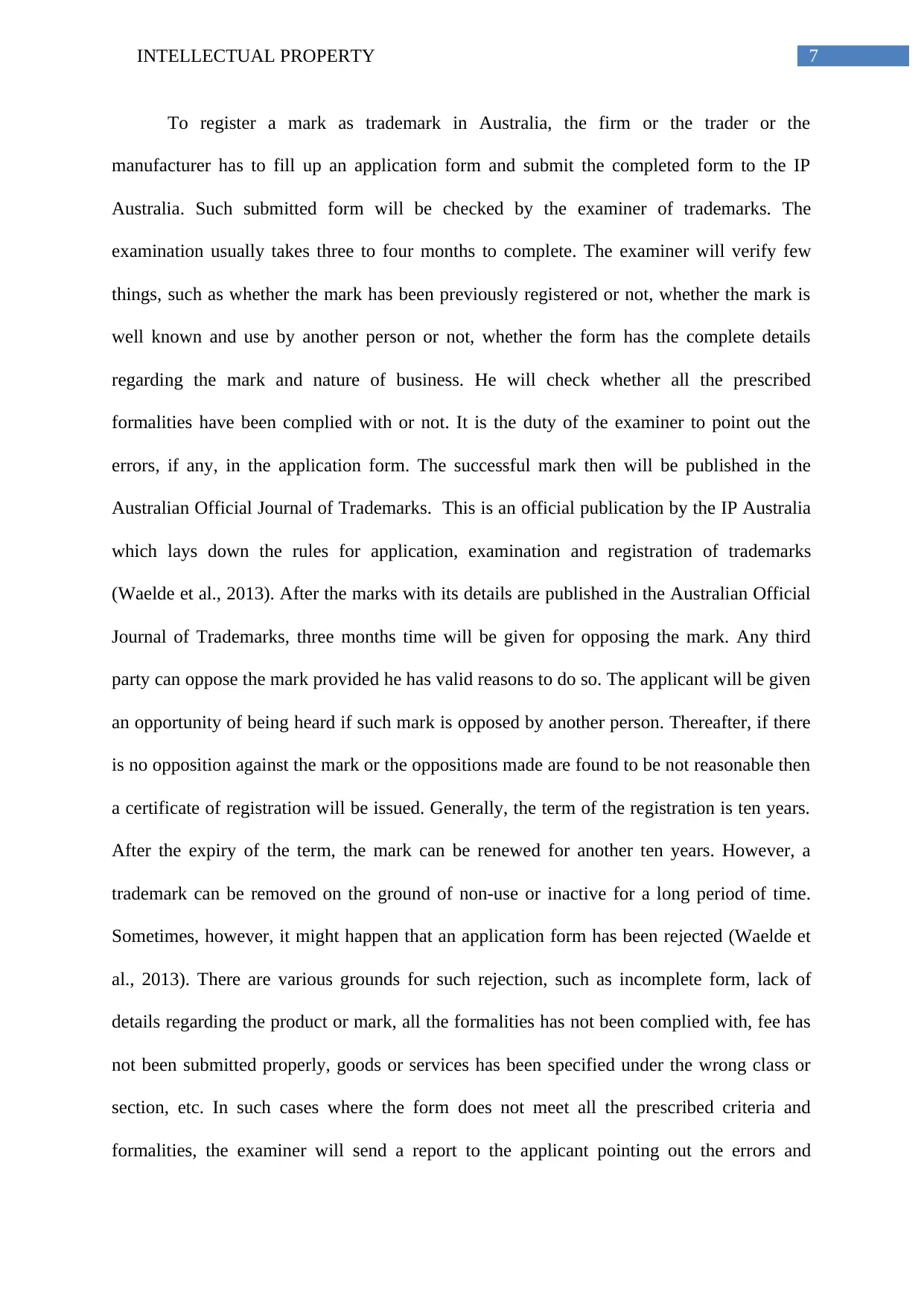
7INTELLECTUAL PROPERTY
To register a mark as trademark in Australia, the firm or the trader or the
manufacturer has to fill up an application form and submit the completed form to the IP
Australia. Such submitted form will be checked by the examiner of trademarks. The
examination usually takes three to four months to complete. The examiner will verify few
things, such as whether the mark has been previously registered or not, whether the mark is
well known and use by another person or not, whether the form has the complete details
regarding the mark and nature of business. He will check whether all the prescribed
formalities have been complied with or not. It is the duty of the examiner to point out the
errors, if any, in the application form. The successful mark then will be published in the
Australian Official Journal of Trademarks. This is an official publication by the IP Australia
which lays down the rules for application, examination and registration of trademarks
(Waelde et al., 2013). After the marks with its details are published in the Australian Official
Journal of Trademarks, three months time will be given for opposing the mark. Any third
party can oppose the mark provided he has valid reasons to do so. The applicant will be given
an opportunity of being heard if such mark is opposed by another person. Thereafter, if there
is no opposition against the mark or the oppositions made are found to be not reasonable then
a certificate of registration will be issued. Generally, the term of the registration is ten years.
After the expiry of the term, the mark can be renewed for another ten years. However, a
trademark can be removed on the ground of non-use or inactive for a long period of time.
Sometimes, however, it might happen that an application form has been rejected (Waelde et
al., 2013). There are various grounds for such rejection, such as incomplete form, lack of
details regarding the product or mark, all the formalities has not been complied with, fee has
not been submitted properly, goods or services has been specified under the wrong class or
section, etc. In such cases where the form does not meet all the prescribed criteria and
formalities, the examiner will send a report to the applicant pointing out the errors and
To register a mark as trademark in Australia, the firm or the trader or the
manufacturer has to fill up an application form and submit the completed form to the IP
Australia. Such submitted form will be checked by the examiner of trademarks. The
examination usually takes three to four months to complete. The examiner will verify few
things, such as whether the mark has been previously registered or not, whether the mark is
well known and use by another person or not, whether the form has the complete details
regarding the mark and nature of business. He will check whether all the prescribed
formalities have been complied with or not. It is the duty of the examiner to point out the
errors, if any, in the application form. The successful mark then will be published in the
Australian Official Journal of Trademarks. This is an official publication by the IP Australia
which lays down the rules for application, examination and registration of trademarks
(Waelde et al., 2013). After the marks with its details are published in the Australian Official
Journal of Trademarks, three months time will be given for opposing the mark. Any third
party can oppose the mark provided he has valid reasons to do so. The applicant will be given
an opportunity of being heard if such mark is opposed by another person. Thereafter, if there
is no opposition against the mark or the oppositions made are found to be not reasonable then
a certificate of registration will be issued. Generally, the term of the registration is ten years.
After the expiry of the term, the mark can be renewed for another ten years. However, a
trademark can be removed on the ground of non-use or inactive for a long period of time.
Sometimes, however, it might happen that an application form has been rejected (Waelde et
al., 2013). There are various grounds for such rejection, such as incomplete form, lack of
details regarding the product or mark, all the formalities has not been complied with, fee has
not been submitted properly, goods or services has been specified under the wrong class or
section, etc. In such cases where the form does not meet all the prescribed criteria and
formalities, the examiner will send a report to the applicant pointing out the errors and
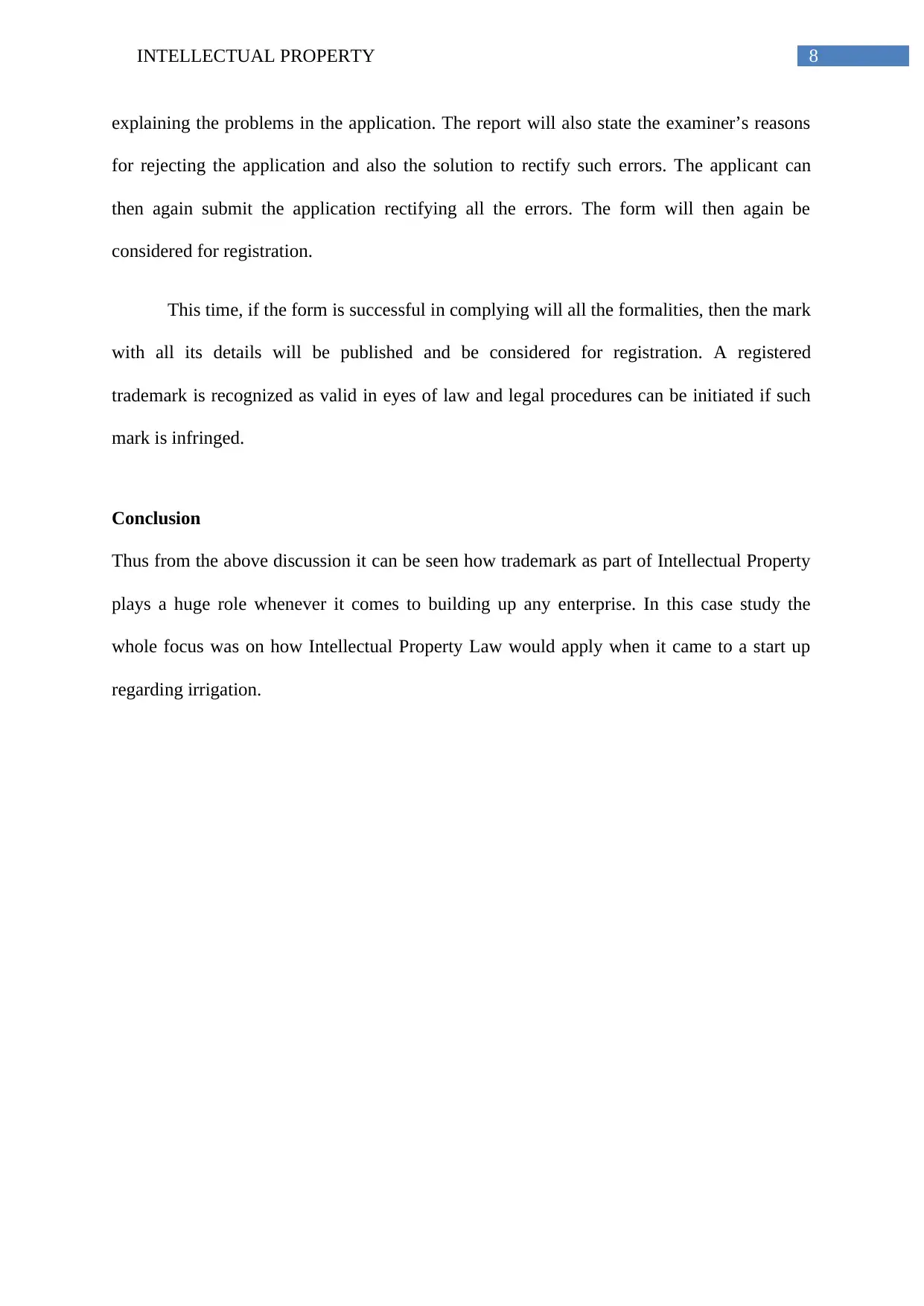
8INTELLECTUAL PROPERTY
explaining the problems in the application. The report will also state the examiner’s reasons
for rejecting the application and also the solution to rectify such errors. The applicant can
then again submit the application rectifying all the errors. The form will then again be
considered for registration.
This time, if the form is successful in complying will all the formalities, then the mark
with all its details will be published and be considered for registration. A registered
trademark is recognized as valid in eyes of law and legal procedures can be initiated if such
mark is infringed.
Conclusion
Thus from the above discussion it can be seen how trademark as part of Intellectual Property
plays a huge role whenever it comes to building up any enterprise. In this case study the
whole focus was on how Intellectual Property Law would apply when it came to a start up
regarding irrigation.
explaining the problems in the application. The report will also state the examiner’s reasons
for rejecting the application and also the solution to rectify such errors. The applicant can
then again submit the application rectifying all the errors. The form will then again be
considered for registration.
This time, if the form is successful in complying will all the formalities, then the mark
with all its details will be published and be considered for registration. A registered
trademark is recognized as valid in eyes of law and legal procedures can be initiated if such
mark is infringed.
Conclusion
Thus from the above discussion it can be seen how trademark as part of Intellectual Property
plays a huge role whenever it comes to building up any enterprise. In this case study the
whole focus was on how Intellectual Property Law would apply when it came to a start up
regarding irrigation.
⊘ This is a preview!⊘
Do you want full access?
Subscribe today to unlock all pages.

Trusted by 1+ million students worldwide
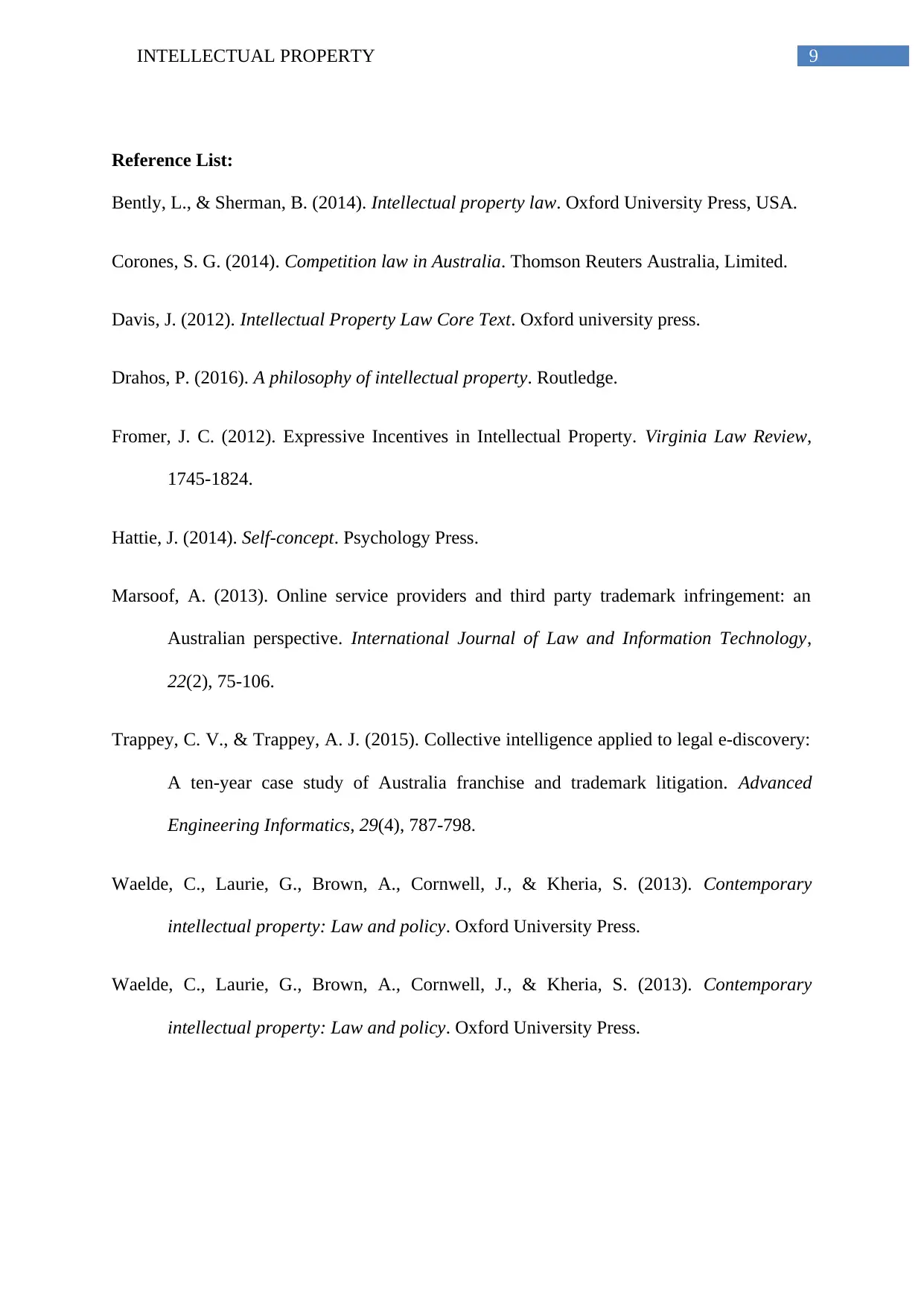
9INTELLECTUAL PROPERTY
Reference List:
Bently, L., & Sherman, B. (2014). Intellectual property law. Oxford University Press, USA.
Corones, S. G. (2014). Competition law in Australia. Thomson Reuters Australia, Limited.
Davis, J. (2012). Intellectual Property Law Core Text. Oxford university press.
Drahos, P. (2016). A philosophy of intellectual property. Routledge.
Fromer, J. C. (2012). Expressive Incentives in Intellectual Property. Virginia Law Review,
1745-1824.
Hattie, J. (2014). Self-concept. Psychology Press.
Marsoof, A. (2013). Online service providers and third party trademark infringement: an
Australian perspective. International Journal of Law and Information Technology,
22(2), 75-106.
Trappey, C. V., & Trappey, A. J. (2015). Collective intelligence applied to legal e-discovery:
A ten-year case study of Australia franchise and trademark litigation. Advanced
Engineering Informatics, 29(4), 787-798.
Waelde, C., Laurie, G., Brown, A., Cornwell, J., & Kheria, S. (2013). Contemporary
intellectual property: Law and policy. Oxford University Press.
Waelde, C., Laurie, G., Brown, A., Cornwell, J., & Kheria, S. (2013). Contemporary
intellectual property: Law and policy. Oxford University Press.
Reference List:
Bently, L., & Sherman, B. (2014). Intellectual property law. Oxford University Press, USA.
Corones, S. G. (2014). Competition law in Australia. Thomson Reuters Australia, Limited.
Davis, J. (2012). Intellectual Property Law Core Text. Oxford university press.
Drahos, P. (2016). A philosophy of intellectual property. Routledge.
Fromer, J. C. (2012). Expressive Incentives in Intellectual Property. Virginia Law Review,
1745-1824.
Hattie, J. (2014). Self-concept. Psychology Press.
Marsoof, A. (2013). Online service providers and third party trademark infringement: an
Australian perspective. International Journal of Law and Information Technology,
22(2), 75-106.
Trappey, C. V., & Trappey, A. J. (2015). Collective intelligence applied to legal e-discovery:
A ten-year case study of Australia franchise and trademark litigation. Advanced
Engineering Informatics, 29(4), 787-798.
Waelde, C., Laurie, G., Brown, A., Cornwell, J., & Kheria, S. (2013). Contemporary
intellectual property: Law and policy. Oxford University Press.
Waelde, C., Laurie, G., Brown, A., Cornwell, J., & Kheria, S. (2013). Contemporary
intellectual property: Law and policy. Oxford University Press.
Paraphrase This Document
Need a fresh take? Get an instant paraphrase of this document with our AI Paraphraser

10INTELLECTUAL PROPERTY
1 out of 11
Related Documents
Your All-in-One AI-Powered Toolkit for Academic Success.
+13062052269
info@desklib.com
Available 24*7 on WhatsApp / Email
![[object Object]](/_next/static/media/star-bottom.7253800d.svg)
Unlock your academic potential
Copyright © 2020–2025 A2Z Services. All Rights Reserved. Developed and managed by ZUCOL.




